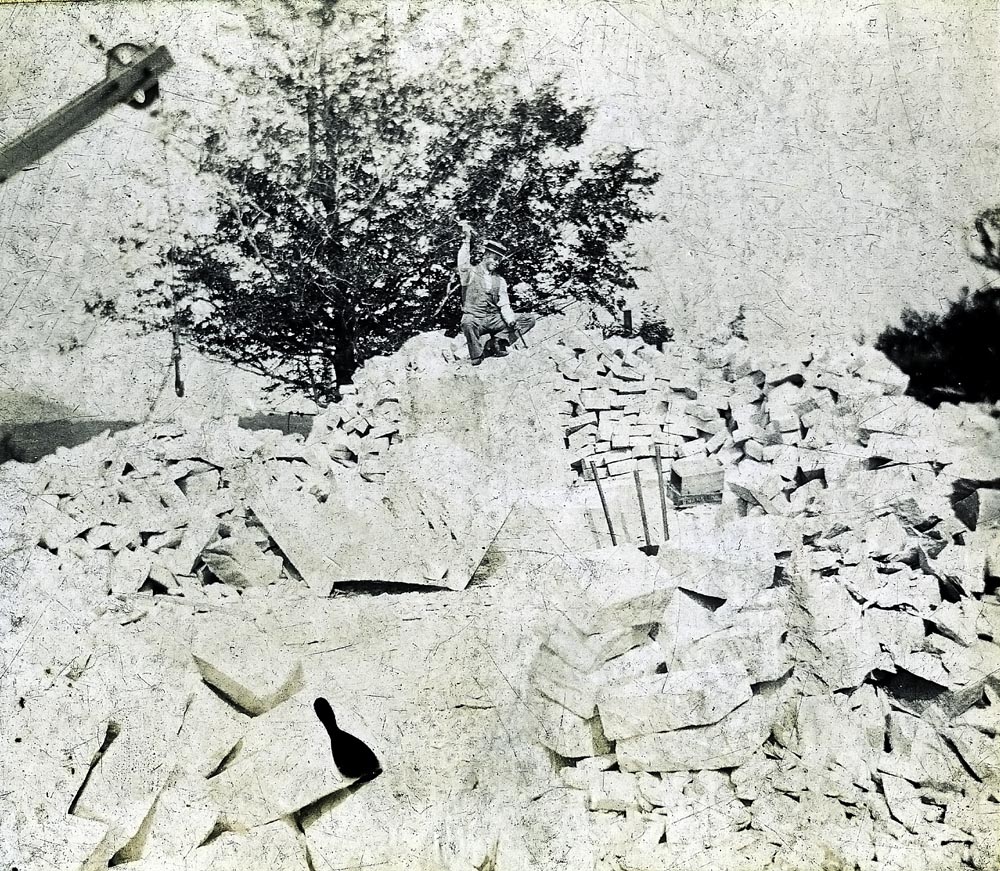
Who on earth is scared of some rocks? Well, what if they are haunted rocks. What if they are the remains of a rock quarry whose rocks were used to make tombstones all across America?
Such is the case at the historic Becket Quarry in the Berkshire Mountains of western Massachusetts. “This abandoned quarry in the hills is just the place for a brush with haunted history,” reads a post on the site Berkshirefamilyfikes.com. “Rusty trucks and forgotten machinery sit deserted, making it one of the more interesting hiking trails in the Berkshires.”
The site lists family hikes, local events, and family-oriented activities for the Berkshire region. Many entail bringing children into nature to discover the wildlife and ecology surrounding them. But in this case, that wildlife has a history.
“Now in a state of arrested decay, the 300-acres was once the thriving site of the Chester-Hudson Quarry, operational from 1860-1947,” the description continues. “The wind at the quarry seems to echo with the voices of the past. The company once shipped tons of stone used for tombstones (eek!), memorials, and other monuments in the area. Even a devastating flood in 1927 didn’t stop operations. Until a seemingly fateful day, when the thundering resonance of machinery screeched to a halt, and the last steam whistle blew on almost three-quarters of a century of granite production in Western Massachusetts. What happened?”
Maybe it was, as some people say, a ghost in the machine? Perhaps one of the people buried beneath a tombstone carved from this quarry somehow returned to haunt the place? Or maybe, as the Berkshire Family Hikes website points out, it was simply “financial mismanagement and lack of capital for necessary improvements.”
Either way, an interesting question is raised. Where does tombstone stone come from?
A post on the website of Merkle Monuments directly answers this question. Merkle is a cemetery monument company that dates back to 1931, when Raymond G. Merkle and Edward Zepp, stonecutters from Granite, Maryland, started with a small display and shop on Liberty Road in Rockdale, Maryland. (The fact the towns of this area are named after rocks seems to suggest this place knows its stuff when it comes to stone!)
“Modern granite headstones, built to last for centuries, come from quarries around the world,” says Merkle. “Some common locations include Vermont, Georgia, Canada, India, China, and Sweden. In many cases, manufacturers source the stones as locally as possible to save on the burden of shipping potentially fragile stones long distances. However, there is a growing trend of American headstone creators sourcing their granite from India but still trying to stay within the USA.”
Merkle says they source much of their granite from Rock of Ages, a granite quarrying and finishing company located in Graniteville, Vermont, founded in 1885.
“At the quarry, granite blocks are cut from the bedrock,” continues Merkle’s post. “Typically, a pneumatic drill is used to bore vertical holes in the granite along the cut line, approximately 20 feet deep. Steel bits with steel teeth are then used to cut away at the core of the rock until a slab is released. A standard granite block measures about 9’ x 5’6” x 4’ and weighs more than 10 tons. After the block is freed from the bedrock, workers attach a cable to it and, using a derrick, lift the block onto the back of the flatbed truck that transports it to a local manufacturer for shaping, sizing, and polishing.”
It all sounds quite professional, and it seems pretty cool that rocks literally carved from the earth by master technicians are transformed into the glossy, beautiful, and dynamic markers and monuments that we see in cemeteries. Of course, tombstones were not always made in this manner, and they were not even always made from stone and rock.
“Headstones were originally made from fieldstones or pieces of wood,” and “in some localities, stones (referred to as ‘wolf stones’) were placed over the body to prevent scavenging animals from uncovering a shallow grave,” reads a post on a website called madehow.com, that expressly provides information on how various everyday products are made.
“Archeologists have found Neanderthal graves that date back 20,000-75,000 years,” the post continues. “The bodies have been discovered in caves with large rock piles or boulders covering the openings. It is thought that these grave sites were accidental. The wounded or dying had probably been left behind to recover, and the rocks or boulders were pushed in front of the cave for protection from wild animals. The Sharindar Cave in Iraq was home to the remains of a person (c. 50,000 B.C. ) with flowers strewn about the body.”
Madehow.com also discusses how the Chinese were the first to use coffins to contain their dead, sometime around 30,000 B.C. And of course, there were the Egyptian pharaohs dating back to 3,200 B.C. They were mummified, embalmed, placed in a sarcophagus, and entombed with statues representing their servants and trusted advisors, as well as gold and luxuries to ensure their acceptance in the world beyond.
Back in New England, the site notes, early headstones were made out of slate, which was available locally. “The next material to become popular was marble, but after time, the marble would erode, and the names and particulars of the deceased were indecipherable,” says the site. “By 1850, granite became the preferred headstone material due to its resilience and accessibility. In modern memorials, granite is the main raw material used.” As the post explains, granite is made from magma, molten material from deep within the earth that is slowly cooled and is such a popular marker in part because the rock can be white, pink, light gray, or dark gray.
The website Cremation Resource points to another positive attribute of this type of rock. “Granite can withstand extreme climates and even acid rain pollution,” the site states. “It is quarried in large blocks and then cleaned, polished, and shaped in the factories to prepare headstones.”
And, of course, cemeteries offer more options than simply headstones, as another funerary website explains. There are flat markers, sometimes called “grass markers,” which lie flat on the ground at the head of the grave, flush with the grass. There are bevel markers, usually about eight inches thick, which lie flat on the ground at the head of the grave and rise above the grass. Slant markers, sometimes called “pillow stones,” are usually about 18 inches tall and sit flat on the ground with the front of the stone angled back, creating a wedge shape. Monuments commonly referred to as “headstones” are tablets standing upright out of the ground. Ledgers are usually about eight inches thick, lie flat on the ground, and cover the entire grave.
As an article posted on the farm and country news site Lancaster Farming notes, most early tombstones were rectangular in shape, often with an arched top. “However…in the late 1700s, ledger stones were used for important members of a community or congregation,” says Lancaster Farming. “These large, flat engraved stones were laid parallel to the ground atop a raised foundation.”
Really it is all about strength and durability. You don’t want your tombstone to break apart under force, crumble in the weather, and erode away after only a short amount of time. You want it to last.
“All rocks are not the same when it comes to how they handle the wear and tear of the hereafter,” explains an article from Wired, the popular technology magazine. The article contains some pretty detailed and interesting tips on tombstone rock types.
“It turns out that making your gravestone (or any monument) from materials like marble is not a good idea for longevity,” says Wired. “Rocks can break down two ways: physically and chemically. Physical weathering is the toll put on rocks by processes like frost/ice splitting, abrasion (from things hitting it), plant roots,” and more. “Chemical weathering is a reaction that occurs when the rock interacts with water, air, and acids,” the article continues. “The two types of weathering work together to make the tallest mountain into nothing more than a pile of sand given enough time.”
The Wired article also offers an invaluable primer on tombstone rock durability.
“If we wanted to rank common gravestone minerals in terms of how quickly they weather,” says Wired, “it would look something like this (from most to least weatherable):
Calcite (Marble is almost 100% calcite)
Olivine (Gabbro)
Plagioclase feldspar (common in gabbro, granite, and almost every igneous rock)
Pyroxene (common in gabbro)
Amphibole (common in diorite to granite)
Biotite (common in granite)
Orthoclase feldspar (common in granite)
Muscovite (somewhat common in granite)
Quartz (really common in granite, quartzite, sandstone)”
It might seem like a complicated list. But one takeaway here is that granite is really a composite of many other types of minerals. And many of these minerals, such as quartz, orthoclase, and biotite, are quite durable and less likely to weather quickly, making granite overall a great tombstone rock choice!
Meanwhile, back in Beckett, Massachusetts, at the historic Becket Quarry, the Summer breeze is still whistling through the large empty pit carved from the granite rock of the Berkshire Mountains to make tombstones.
“If you let the preserved ruins (and your imagination) speak to you,” says the Berkshire family hikes website, “maybe you’ll hear” something.









